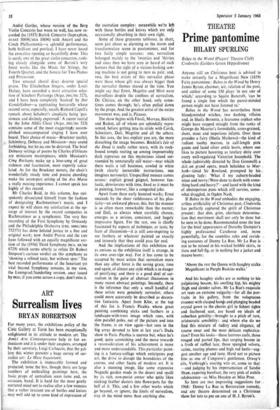Surrealism lives
ART BRYAN ROBERTSON
For many years, the exhibitions policy of the Civic Gallery at Turin has been exceptionally enlightened in its attitude to modern art. The Andel Arte Contemporanea help to fan en- thusiasm and it is under their auspices, arranged by their secretary, Luigi Carluccio, that the gal- lery this winter presents a huge survey of sur- realist art : Le Muse Inquietanti.
The exhibition is impeccably formed and projected; none the less, though there are large numbers of enthralling paintings here, the basic props of surrealism seem tame and, on occasion, banal. It is hard for the most gently nurtured mind not to realise after a few minutes that a rather insistent use of bottles and knives may well add up to some kind of expression of
the castration complex: meanwhile we're left with those bottles and knives which are only occasionally absorbing in their own right.
Some of these gruesome tableaux, in short, seem just about as alarming as the storm and transformation scene in pantomimes, and for two fairly simple reasons: one, surrealism belonged mainly to the 'twenties and 'thirties and since then we have seen or heard of such horrors that the sight of a vicious-looking sew- ing machine is not going to turn us pale; and, two, the best artists of this surrealist phase were those whose gift was always bigger than the surrealist themes shared at the time. You might say that Ernst, Magritte and Miro were marvellous despite the confines of surrealism, De Chirico, on the other hand, only some- times comes through; he's often pulled down by the props. And the greatest artist of the entire movement was, and is, Picasso.
The show begins with Fassli, Moreau, 'Rocklin and Redon, all of whom are splendidly repre- sented, before gettinginto its stride with Cara, Schwitters, Dali, Magritte and all the others. In this area, the less explicit you are, the more disturbing the image becomes. 'Rocklin's Isle of the Dead is really rather scary, with its rock- bound temple rearing up among impenetrably dark cypresses on this mysterious island sur- rounded by unnaturally still water—near which there waits a tall boatman, cowled in white (with clearly inexorable instructions, one imagines nervously). Unspecified menace comes across : explicit grand guignol, however fan- tastic, deteriorates with time, fixed as it must be in painting, forever, like a congealed joke.
Apart from these early haunted works, Ernst succeeds by the sheer ruthlessness of his plas- ticity—an awkward phrase, this, but the manner is so often more remarkable than the matter; and Dali, as always when carefully chosen, emerges as a serious, consistent, and hugely impressive figure. For the rest, one is chiefly fascinated by aspects of technique, or taste, by feats of illusionism—it is still awe-inspiring to see feathers or whatever painted so exactly and intensely that they could pass for real.
And the implications of this exhibition are as curious as the exhibition itself is strange, in its own over-ripe way. For it has come to be accepted by most artists that surrealism more • than any other force is the saving grace, time and again, of almost any style which is in danger of petrifying; and there is a good deal of sur- realism in the guise of abstract illusionism in many recent abstract paintings. Secondly, there is the inference that only a small handful of these artists were genuinely surrealist; others could more accurately be described as decora- tive fantasists. Apart from Klee, at the top of this list is Francis Picabia whose great painting combining sticks and feathers in a landscape-with-trees image which runs, with slim parallel poles, out of the picture and into the frame, is on view again—last seen in the big array devoted to him at last year's Dada show in Paris. Picabia is uneven but, when he's good, quite astonishing and the move towards a reconsideration of his achievement is more and more understandable. This particular paint- ing is a fantasy-collage which anticipates pop art, the drive to disrupt the boundaries of the canvas, and other facets of modern art. It is also a stunning image, like some expensive Noguchi garden made in the desert and spoilt by its rich, non-purist owner who quite likes sticking feather dusters into flowerpots for the hell' of it. This, and a few other works which go beyond, or ignore, the limits of surrealism, stay in the mind more than anything else.


































 Previous page
Previous page